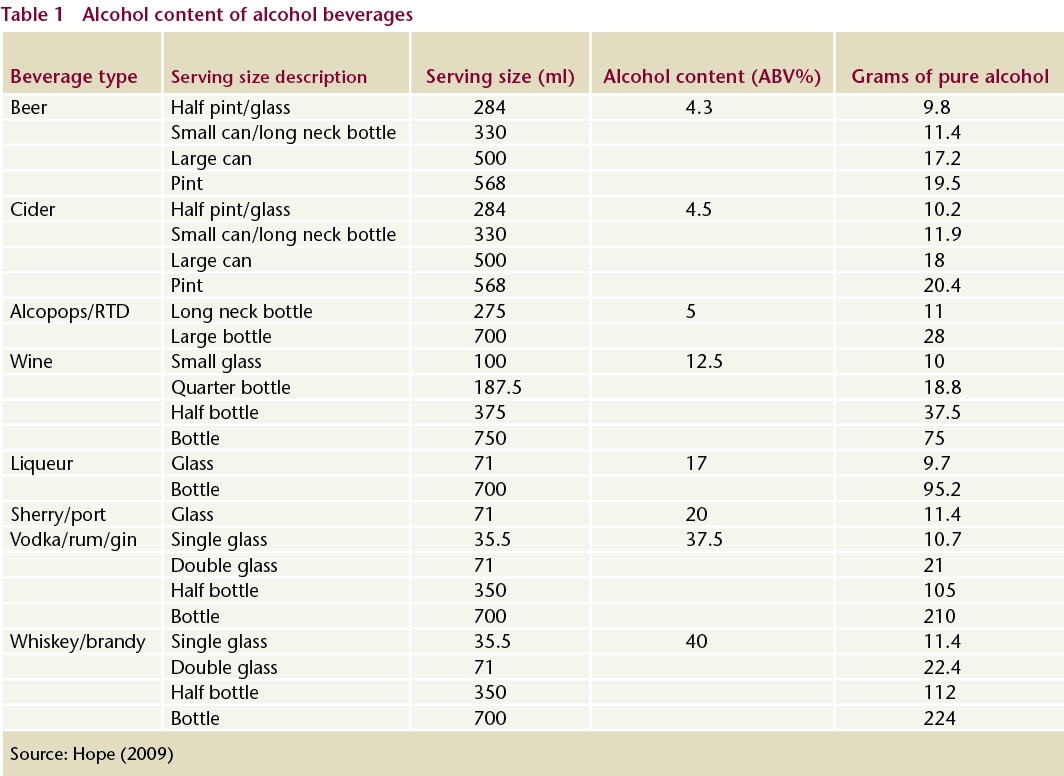Hope, Ann and Mongan, Deirdre
(2010)
What constitutes a 'standard drink'?
Drugnet Ireland,
Issue 32, Winter 2009,
pp. 4-5.
Alcohol has harmful properties; it is an intoxicant and a drug, and the risks associated with it are extensive. There is no clear level of drinking below which alcohol-related accidents, injuries or diseases do not occur. In other words there is no known ‘safe’ or ‘sensible’ level of alcohol consumption for any one individual. A recent report by the Health Service Executive examined the different alcoholic beverages currently available in Ireland in terms of beverage categories, the alcohol content, the serving size of typical drinks and other relevant information.1
There is limited evidence of an impact of alcohol warning labels on drinking behaviour and alcohol-related harm. However, a European report on alcohol and labelling2 concluded that consumer protection principles would suggest that where there are risks to health in consuming alcohol, particularly during pregnancy, when taking medication, or when driving or operating machinery, consumers should be informed about those risks.
In Ireland, there is much confusion about what constitutes a typical or ‘standard drink’. Part of the confusion stems from the use of the ‘UK unit’, which is inappropriate in the Irish context. The UK unit was devised in the early 1970s as a simple method to calculate the alcoholic strength in different drinks. The purpose was to help scientists and health professionals in the clinical setting estimate alcohol consumption for comparative purposes. The measure used was called a ‘unit of alcohol’ and related to the most common drinks and alcohol content of drinks served in the UK. A ‘UK unit of alcohol’ is found in a half pint of beer (3.5% ABV) or a small glass of wine (100 ml) or a single measure of spirits (1/6 gill) and equals 8 grams of pure alcohol. Although the UK unit was used in Ireland, it did not reflect the typical strength or serving measure of drinks sold in Ireland, where a single measure of spirits is larger, at 1/4 gill. It is therefore not appropriate to use the UK unit measure when describing a standard drink in Ireland.
A pilot study undertaken in 2000 showed that a typical drink in Ireland was equal to 10 grams of alcohol and called a ‘standard drink’.3 In the international arena, a standard drink is the usual term used. The UK unit (8 grams) is the lowest standard drink measure used. Some countries, including Spain, Italy, New Zealand and Australia, use 10 grams as their standard drink measure.
To establish the standard drink in Ireland, the first step was to calculate the amount of pure alcohol in each of the alcoholic beverages. This involved multiplying the serving size of the drink (millilitres) by the alcohol content (% ABV) of the drink and dividing by 1.25 (1 ml=1.25 g) to establish the grams of pure alcohol in that specific drink (Table 1).

Two of the most popular serving sizes, a pint of beer and a quarter bottle of wine, are often mistakenly regarded as a standard drink where in fact they are equivalent to two standard drinks each. As a general guide for low-risk drinking, the recommended upper weekly limit used in Ireland is based on the UK unit – 14 units for women and 21 units for men. However, when those low risk drinking guidelines are translated into Irish standard drinks (10 grams), the Irish low risk weekly guidelines should be 11 standard drinks for women and 17 standard drinks for men. To provide a general estimate of the average number of standard drinks consumed in Ireland, the per capita figures for 2006 were utilised. This suggests that on average approximately 21 standard drinks are consumed each week by every adult aged 15 years and over. This is a conservative figure given that abstainers are not excluded and represent about 20% of the adult population. Over a year this level of drinking is equivalent to 548 pints or 143 bottles of wine or 51 bottles of vodka per adult.
It is hoped that the findings of this study will help clinicians and health professionals to more accurately assess patient alcohol intake, provide a valid measure for inclusion in alcohol screening tools and help to inform policy on product labelling and provision of other relevant health information.
1. Hope A (2009) A standard drink in Ireland: what strength? Dublin: Health Service Executive.
2. Deutsche Hauptstelle Fur Suchtfragen e.V. (DHS) (2008) Consumer labelling and acoholic drinks. Hamm: DHS (German Centre for Addiction Issues).
3. Hope A (2000) Typical drinks in Ireland. Dublin: Department of Health and Children.
